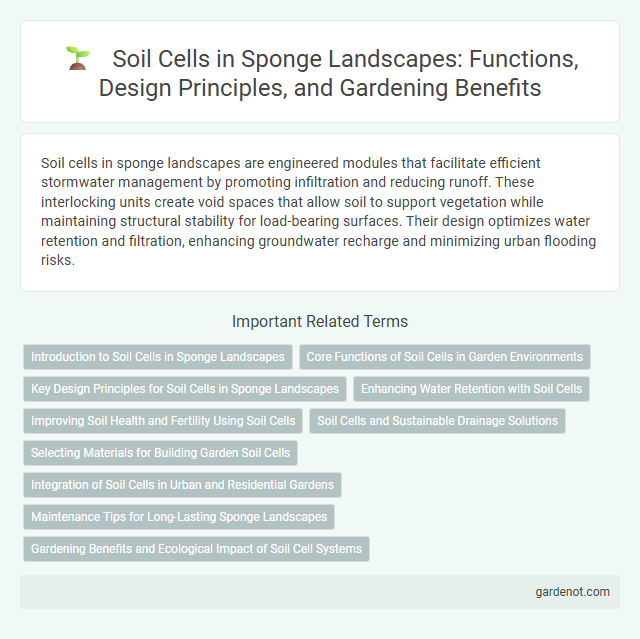Soil cells in sponge landscapes are engineered modules that facilitate efficient stormwater management by promoting infiltration and reducing runoff. These interlocking units create void spaces that allow soil to support vegetation while maintaining structural stability for load-bearing surfaces. Their design optimizes water retention and filtration, enhancing groundwater recharge and minimizing urban flooding risks.
Introduction to Soil Cells in Sponge Landscapes
Soil cells in sponge landscapes are modular structural units designed to support healthy soil by promoting water retention, root growth, and aeration. These engineered cells stabilize soil and reduce compaction, enhancing infiltration and mitigating surface runoff in urban green infrastructure. Integrating soil cells improves the resilience and functionality of sponge landscapes, critical for sustainable stormwater management.
Core Functions of Soil Cells in Garden Environments
Soil cells play an essential role in garden environments by providing structural support and enhancing soil aeration, which promotes healthy root growth. They facilitate effective water infiltration and retention, reducing runoff and ensuring adequate moisture availability for plants. These core functions of soil cells contribute to sustainable garden ecosystems by improving drainage and nutrient cycling.
Key Design Principles for Soil Cells in Sponge Landscapes
Soil cells in sponge landscapes prioritize load-bearing capacity, root zone optimization, and efficient water infiltration to promote healthy vegetation and manage stormwater effectively. Key design principles include modularity for flexible installation, high porosity for enhanced aeration, and structural strength to support soil and surface loads. Integrating robust drainage channels within soil cells ensures retention and gradual release of stormwater, reducing urban flooding risks.
Enhancing Water Retention with Soil Cells
Soil cells significantly enhance water retention by providing structured support that prevents soil compaction and promotes optimal water infiltration. Engineered to create void spaces, these cells enable efficient water storage and root oxygenation, reducing runoff and improving plant health. Integrating soil cells into sponge landscapes maximizes groundwater recharge and sustains vegetation during dry periods.
Improving Soil Health and Fertility Using Soil Cells
Soil cells enhance soil health and fertility by providing structural support that prevents compaction, allowing roots to penetrate deeply and access essential nutrients. These modular units facilitate optimal water retention and aeration, promoting a balanced microbial ecosystem critical for nutrient cycling. Integrating soil cells in sponge landscapes ensures sustained soil productivity and resilience against erosion and degradation.
Soil Cells and Sustainable Drainage Solutions
Soil cells are integral components of sustainable drainage solutions, enabling efficient stormwater management by supporting healthy soil structure and root growth. These modular units distribute load while preserving soil permeability, reducing surface runoff and mitigating flooding risks in urban landscapes. Implementing soil cells enhances groundwater recharge and promotes green infrastructure resilience by maintaining natural hydrological cycles.
Selecting Materials for Building Garden Soil Cells
Selecting materials for building garden soil cells involves prioritizing permeable, durable substances such as recycled plastic or fiberglass, which support water infiltration and root growth. Incorporating materials with high load-bearing capacity ensures structural stability while maintaining soil aeration. Utilizing eco-friendly, UV-resistant composites enhances longevity and sustainability in sponge landscape designs.
Integration of Soil Cells in Urban and Residential Gardens
Soil cells provide essential structural support and promote healthy root growth by improving soil aeration and drainage in urban and residential gardens. Their integration helps manage stormwater runoff, reducing soil erosion and surface flooding while enhancing groundwater recharge. This sustainable landscape solution supports plant vitality and contributes to resilient urban ecosystems.
Maintenance Tips for Long-Lasting Sponge Landscapes
Regular inspection of soil cells ensures proper drainage and prevents root damage in sponge landscapes. Clearing debris and checking for soil compaction extends the functionality and lifespan of the soil cell system. Implementing routine maintenance, such as flushing and refilling cells with nutrient-rich soil, supports healthy vegetation and sustainable water management.
Gardening Benefits and Ecological Impact of Soil Cell Systems
Soil cell systems enhance gardening by promoting healthy root growth and improving water retention, which reduces the need for frequent irrigation. These systems support urban green spaces by filtering pollutants and mitigating stormwater runoff, thereby contributing to ecological balance. Incorporating soil cells in landscaping fosters sustainable vegetation growth while protecting surrounding ecosystems from erosion and contamination.
Soil cell Infographic

 gardenot.com
gardenot.com